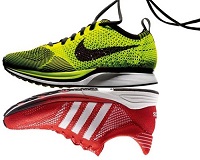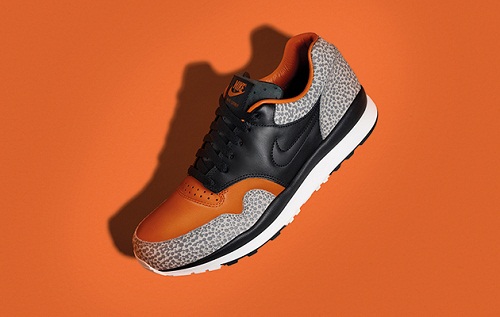"With environmental consciousness penetrating societies around the world along with an acute cultural shift towards athleticism and wellness, manufacturers are increasingly focusing on producing knitted shoes. Footwear brands Nike and Adidas launched a line of virtually seamless, knitted shoe uppers in 2012. The seamless designs of these shoes provide an almost “second-skin” feel besides eliminating waste by almost 60 per cent as in the case of the Nike FlyKnit – while simultaneously reducing labor hours and environmental impact, improving inventory management, accelerating to market time, and allowing for ultimate customisation."
 With environmental consciousness penetrating societies around the world along with an acute cultural shift towards athleticism and wellness, manufacturers are increasingly focusing on producing knitted shoes. Footwear brands Nike and Adidas launched a line of virtually seamless, knitted shoe uppers in 2012. The seamless designs of these shoes provide an almost “second-skin” feel besides eliminating waste by almost 60 per cent as in the case of the Nike FlyKnit – while simultaneously reducing labor hours and environmental impact, improving inventory management, accelerating to market time, and allowing for ultimate customisation.
With environmental consciousness penetrating societies around the world along with an acute cultural shift towards athleticism and wellness, manufacturers are increasingly focusing on producing knitted shoes. Footwear brands Nike and Adidas launched a line of virtually seamless, knitted shoe uppers in 2012. The seamless designs of these shoes provide an almost “second-skin” feel besides eliminating waste by almost 60 per cent as in the case of the Nike FlyKnit – while simultaneously reducing labor hours and environmental impact, improving inventory management, accelerating to market time, and allowing for ultimate customisation.
However, there are distinct limitations to the current seamless knitting technology. The process is markedly less labor intensive than the traditional cut-and-sew methods. Also, it is not yet fully automated. Shoe upper manufacturers are therefore opting for 3D knitting, which eliminates human labor from the production process and breaks through the seamless knitted shoe bottleneck.
Automating shoe manufacturing
3D seamless knitting technology enables flat knitting machines to produce a complete shoe upper, ready to be directly connected to the sole, with a single machine. This leap in knitting technology presents an exciting possibility of completely eliminating labor-dependent cutting, sewing and heat-setting from the shoe production process – and fully automating shoe upper manufacturing.
Raw materials also represent a considerable expense in the shoe manufacturing process, which is only aggravated by extreme fabric waste. By using 3D knitting solutions, each upper can be completed individually and requires no cutting or sewing post-production, resulting in a completely seamless shoe upper — and reducing waste by as much as 60 per cent, in the case of the Nike FlyKnit.
fabric waste. By using 3D knitting solutions, each upper can be completed individually and requires no cutting or sewing post-production, resulting in a completely seamless shoe upper — and reducing waste by as much as 60 per cent, in the case of the Nike FlyKnit.
Replacing leather with textiles also has a positive impact on the environment. Leather shoes are responsible for an estimated 30-80 per cent of global impacts on all metrics, including climate change, resource use and freshwater withdrawal. This is in stark contrast to textile shoes, which only represent 6-21 per cent of total impact in the same categories.
Reduced delivery times
If the lifecycle of modern trends has been compressed to just 3.5 years, the concept-to-market process will need to be adjusted accordingly. The Adidas Speed factory is one attempt to close this gap. By bringing production closer to consumers, Adidas has managed to accelerate to market time by a factor of 3. In the future, Adidas hopes their Speedfactory will be able to complement their original production lines by quickly producing limited runs of customized products, or replenishing certain products that are selling more quickly than expected. 3D knitting opens the possibility of streamlining concept-to-market time by implementing a realistic local production solution.
3D knitting offers a solution to inventory problems. Rather than estimate consumer demand months ahead of time – and risk losses due to unsold inventory – 3D knitting opens the possibility to manufacture locally according to real-time demand. While this particular solution is still in its infancy, there is plenty of potential for 3D knitting to begin developing in this direction. With 3D knitting solution, customers can order customised shoes and have them delivered within a few days, cutting down manufacturing and distribution time from several months to just a few days.
A long way to go to be fully adopted
For a 3D knitting solution to truly become practical, it needs to be able to knit a double-sided upper while maintaining the versatility and flexibility of shoe uppers. The seamless shoe uppers are manufactured using a slightly improved sock machine, producing an end product that is much too thin, ‘tongue-less’, and rather limited in terms of design possibilities. As such, current technologies still require a certain amount of processing post-production. There is still a lot of room for improvement, but it’s certainly an exciting industry to watch.












